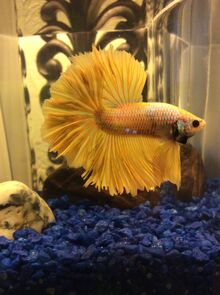Bettas come in various different colors. If you combine patterns, colors, and fin types, you can come up with

A beautiful example of a "Opaque" betta.
over 2,000 variations!
Pictures coming soon
Taken from here
Red[]
The color red is dominate in bettas, and a well-bred, healthy betta should be cherry-red or dark red. Solids are completely red, but red bettas often have blue-green scales and depending on the type, an outline of blue-green or black. There are various different combinations of red.
Blue[]
There are several shades of blue seen in Bettas. These are Steel Blue, where the blue is cold and grayish in appearance, Royal Blue, where the blue is rich, deep and vibrant and Turquoise, where the fish can appear both green and blue in certain lights. Blue Bettas often have a dark blue or black face. The color blue can show in red Bettas as "blue wash". Blue bettas often have a single red pelvic fin.

Blue veil tail
Green[]
True green is not often seen in Bettas; it is more often to be turquoise. Dark green, lime green, or even standard has never been breed. The closet to green is a pale, shimmery green-blue.
Cellophane/Pastel[]
Cellophane Bettas have a colorless body and translucent fins with black eyes. Pastel Bettas have the almost-translucent fins with hints of color including blue, red or green, and the characteristic black eyes. The Grizzled Pastel has smatterings of broken color in some of the scales on the body.
Opaque[]
Opaque Bettas are a misty white in color with hazy eyes. The gene that makes Bettas this color also causes internal organ problems. A true pure opaque white is rare, and often there will be imperfections. A good breeder can, however, breed a perfect white betta.
Yellow & Pineapple[]
Yellow Bettas usually carry the desirable red-loss gene that causes Bettas to not have red-wash. They will often also carry and throw fry that are iridescent blue and green. Yellow varies from very pale yellow to rich buttery yellow. Pineapple refers to yellow Bettas with darker definitions around their scales on their body, giving them a slightly "dirty" appearance.
Orange[]
Not often seen, Orange Bettas are usually a bright, eye-popping, rich tangerine color and can appear red in bad lighting. Some may have pale or translucent fins. They are often completely solid.
Orange Dalmatian[]
Again, this is not often seen and can also be referred to as Apricot Spots. It is when the body is a pale orange as are the fins, but throughout the fins are much richer orange-red spots of varying size and shape. These are much rarer and hard to find.
Black[]
There are four (4) classes of Black Bettas. The first is Melano, which has a dark, almost black midnight blue body and black fins and are generally infertile; black orchid, a deep black with clear fins where they're webbed; Super Black, pure black with possible tiny dark blue scales; and copper blacks with copper-colored streaks with iridescence.
Purple[]
Pure purple Bettas are almost unheard of but those close to it have been seen including rich violets, or blues with copper iridescence. Some purples may look blue or red in certain lights, and only show their true color under bright light. They are a stunning violet with lighter pink fins and darker pelvis fins.
Mustard Gas[]
This strange name refers to Bettas with a green, blue, or steel blue body and yellow or orange fins, it is a bicolor pattern. They often have a blue body with light yellow fins and blue edges.
Chocolate[]
Chocolate Bettas are so called as they do appear a rich brown in color, and will often have yellow coloration through the fins. Not often seen, and very rare.
Copper[]
This is a highly iridescent strain of Betta that is very popular. It is silver or brown when under weak light, but when under good lighting it will shimmer a copper color with purple or blue highlights. This color originates from wild type Bettas who had a gold sheen to them.
The copper gene has now been bred into various colors and new patterns are emerging all the time.
Albino[]
Albino Bettas are very rare- only a few have been confirmed. They do not have long lifespans and will go blind fairly early on in life, making it near impossible to breed them.
Transparent with Color[]
An unofficial name, this refers to a betta with a solid body of any color, possibly extending out, with clear fins in the middle and possibly a thin layer of color on the edge of the fins.
Bicolor[]
Bicolor refers to a betta with one solid color on the body, and one different solid color on the fins.


